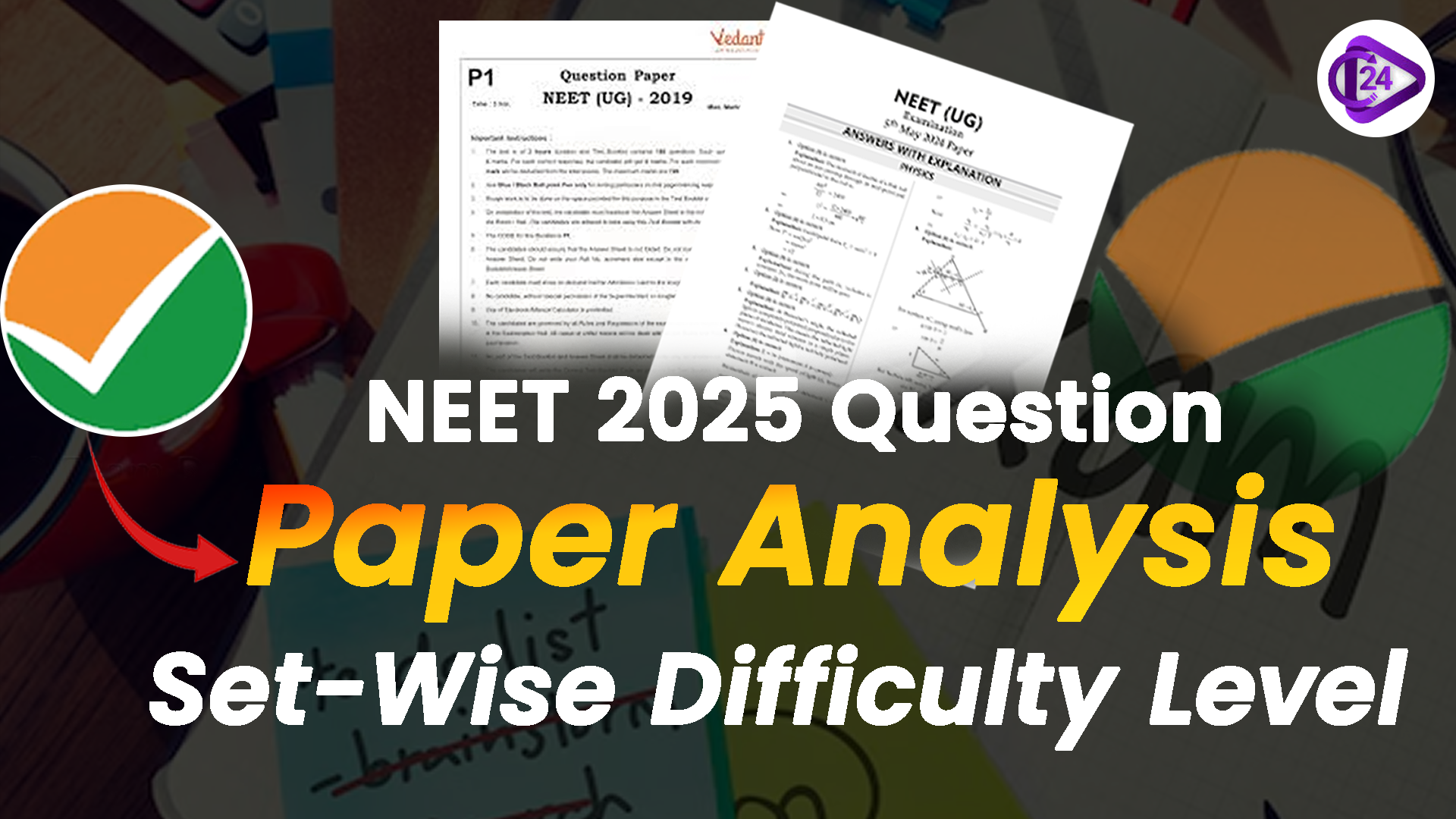NEET 2025 serves as a crucial examination that selects medical school candidates for admission across all prestigious colleges in India. Students need to understand both the difficulty level of the question paper and the structure to improve their chances of success as competition grows each year. This thorough evaluation of the NEET 2025 Question Paper explores test configuration, topic breakdown, and general challenge levels so future applicants can receive critical information. This blog contains complete details to guide students toward NEET 2025 success by explaining question pattern trends and study preparation advice.

Students need to prepare intensely and develop smart tactics as the NEET exam presents extremely difficult content that exceeds its large syllabus. This examination of the NEET 2025 question paper provides detailed information about the subject breakdown as well as specific chapter breakdowns. Our assessment of subjects, including Physics and Chemistry, and Biology in NEET, will guide students toward creating better preparation strategies to enhance their exam success potential.
NEET 2025 Question Paper Analysis: Overview
The NEET 2025 question paper maintains a standardized exam format to evaluate student capabilities in Physics, Chemistry, and Biology based on 200 multiple-choice questions split by subject into three equal sets. The table below provides an overview of the NEET question paper, which was conducted on May 4, 2025.
NEET 2025 Paper Analysis
| Particulars | Details |
|---|---|
| Mode of Examination | Pen and paper-based |
| Total Questions | 180 questions |
| Sections | Physics, Chemistry, Biology (Botany & Zoology) |
| Question Type | Multiple Choice Questions (MCQs) |
| Duration | 3 hours |
| Marking Scheme | +4 for correct answer, -1 for incorrect answer |
| NEET 2025 Physics Paper Analysis | NEET 2025 Biology Paper Analysis | NEET 2025 Chemistry Paper Analysis |
NEET 2025 Question Paper Pattern
The NEET 2025 exam adopts a detailed evaluation structure that tests medical aspirants on their knowledge depth and application skills across Physics, Chemistry, and Biology. The examination consists of 180 multiple-choice questions distributed equally among three subjects, which includes 45 questions from each section. The standardized format provides an even distribution for assessing candidate skills in all three subject domains.
NEET 2025 Subject-wise Distribution
| Subject | Number of Questions | Total Marks |
|---|---|---|
| Physics | 45 | 180 |
| Chemistry | 45 | 180 |
| Biology (Botany + Zoology) | 90 | 360 |
NEET 2025 Question Paper Difficulty Level
NEET 2025 established itself as one of the most competitive editions in recent times because of its complex content and its requirement for extended time dedication. The National Testing Agency (NTA) implemented a major change by lowering paper set distribution from the typical 24 to four sets, which tested students on application-based knowledge without prioritizing memorization skills.
NEET 2025 Biology Paper Analysis
The Biology section presented conceptual understanding challenges, even though it included many detailed questions. This section followed the NCERT syllabus exclusively, except for one question outside the official school textbook. The questions were straightforward, but the examination required thorough reading of each question as well as proper time management, thus making this portion longer than it was difficult.
NEET 2025 Biology Topics Analysis
| Topic | Difficulty Level (1-5) | Good Attempts |
|---|---|---|
| Molecular Basis of Inheritance | 3 | 5–6 |
| Cell Cycle & Cell Division | 2 | 4–5 |
| Human Physiology | 3 | 5–6 |
| Plant Physiology | 2 | 4–5 |
| Reproduction | 3 | 5–6 |
| Genetics | 4 | 5–6 |
| Ecology | 3 | 5–6 |
| Biotechnology | 4 | 5–6 |
| Microbes in Human Welfare | 3 | 5–6 |
NEET 2025 Physics Paper Analysis
The physics section proved to be the toughest segment because Mechanics dominated the test content. The questions spanned several pages and needed complex numerical work, so students required excellent conceptual understanding in combination with analytical abilities. The assessment contained a complete absence of assertion-reasoning or match-the-column questions, with Class 11 topics forming the basis for most of the questions.
NEET 2025 Physics Topics Analysis
| Topic | Difficulty Level (1-5) | Good Attempts |
|---|---|---|
| Mechanics (Kinematics, Laws of Motion) | 4 | 6–7 |
| Work, Energy, and Power | 3 | 4–5 |
| Thermodynamics | 4 | 4–5 |
| Optics | 3 | 4–5 |
| Modern Physics (Atoms, Nuclei) | 4 | 5–6 |
| Electrostatics | 4 | 5–6 |
| Current Electricity | 4 | 5–6 |
| Magnetism and Matter | 4 | 5–6 |
| Fluid Mechanics | 3 | 4–5 |
| SHM and Waves | 3 | 4–5 |
NEET 2025 Chemistry Paper Analysis
Students faced both moderate and difficult questions in their Chemistry exam, which heavily focused on the Organic and Physical Chemistry sections. Students spent more time answering the exam questions than they had in past years because the questions contained statement-based questions along with matrix-match and assertion-reason questions. The section demanded students to demonstrate both in-depth conceptual mastery and application skills across all topics.
NEET 2025 Chemistry Topics Analysis
| Topic | Difficulty Level (1-5) | Good Attempts |
|---|---|---|
| Organic Chemistry (Hydrocarbons, Alcohols, etc.) | 4 | 6–7 |
| Physical Chemistry (Thermodynamics, Kinetics) | 4 | 5–6 |
| Inorganic Chemistry (p-block, d-block) | 4 | 5–6 |
| Chemical Bonding and Molecular Structure | 4 | 5–6 |
| Solutions and Colligative Properties | 3 | 4–5 |
| Coordination Compounds | 4 | 5–6 |
| Electrochemistry | 3 | 4–5 |
| Biomolecules | 3 | 4–5 |
| Environmental Chemistry | 3 | 4–5 |
| Surface Chemistry | 3 | 4–5 |
Class-Wise NEET 2025 Question Paper Analysis
The NEET 2025 examination allocated subject matter uniformly between Class 11 and Class 12 material during its three sections. Each subject had a different question distribution between Class 11 content and Class 12 content, yet the combined ratio was 45% from Class 11 and approximately 55% from Class 12. The examination approach provided students with a thorough assessment of the entire academic content.
NEET 2025 Subject-wise Focus and Distribution
| Subject | Class 11 Questions | Class 12 Questions | Class 11 Topics Focused | Class 12 Topics Focused |
|---|---|---|---|---|
| Physics | 20 | 30 | Mechanics | Optics, Modern Physics, Electrostatics |
| Chemistry | 22 | 28 | Inorganic and Physical Chemistry | Organic Chemistry |
| Biology | 27 | 23 | Genetics, Ecology, Cell Biology | Reproduction, Biotechnology, Human Physiology |
Chapter-wise NEET 2025 Paper Analysis
The successful preparation for NEET 2025 depends on students knowing which chapters hold more weightage. The study of major chapters allows students to use their time efficiently to enhance their test scores. The following breakdown provides precise details about the Physics, Chemistry, and Biology chapter distribution according to the predicted weightage for NEET 2025.
Physics Chapter-Wise Weightage
The NEET 2025 Physics section will emphasize studying Laws of Motion, Thermodynamics, and Magnetic Effects of Current & Magnetism from Class 11, alongside Electrostatics, Optics, and Electromagnetic Induction from Class 12. The examination distributes its questions into 20 Class 11 topics and 30 Class 12 topics. Students need to master basic concepts together with practice numerical problems because Physics demands intricate mathematical operations.
NEET 2025 Physics Chapter Analysis
| Class | Chapter | Weightage (Approx.) | Key Focus Areas |
|---|---|---|---|
| Class 11 | Laws of Motion | 3 questions | Newton’s Laws, Friction, Circular Motion |
| Class 11 | Motion in a Plane | 2 questions | Projectile Motion, Relative Velocity |
| Class 11 | Work, Energy, and Power | 3 questions | Work-Energy Theorem, Conservation of Energy |
| Class 11 | Rotational Motion | 3 questions | Torque, Moment of Inertia, Angular Momentum |
| Class 11 | Gravitation | 2 questions | Gravitational Potential Energy, Kepler’s Laws |
| Class 11 | Thermodynamics | 3 questions | Laws of Thermodynamics, Heat Transfer |
| Class 11 | Behaviour of Perfect Gas and Kinetic Theory | 2 questions | Gas Laws, Kinetic Theory of Gases |
| Class 11 | Properties of Bulk Matter | 2 questions | Elasticity, Fluid Mechanics |
| Class 11 | Electrostatics | 2 questions | Coulomb’s Law, Electric Fields, Potential |
| Class 11 | Current Electricity | 3 questions | Ohm’s Law, Kirchhoff's Law |
| Class 11 | Magnetic Effects of Current and Magnetism | 3 questions | Magnetic Field, Ampere’s Law, Magnetic Force |
| Class 12 | Electrostatics | 3 questions | Capacitors, Electric Potential, Gauss’ Law |
| Class 12 | Current Electricity | 3 questions | Conductors, Insulators, Electrical Circuits |
| Class 12 | Magnetic Effects of Current & Magnetism | 3 questions | Solenoids, Magnetic Fields, Magnetic Induction |
| Class 12 | Electromagnetic Induction | 3 questions | Faraday’s Law, Lenz’s Law, Self and Mutual Induction |
| Class 12 | Electromagnetic Waves | 2 questions | Wave Properties, Electromagnetic Spectrum |
| Class 12 | Optics | 3 questions | Refraction, Reflection, Optical Instruments |
| Class 12 | Dual Nature of Matter and Radiation | 2 questions | Photoelectric Effect, de Broglie Wavelength |
| Class 12 | Atoms and Nuclei | 3 questions | Bohr’s Model, Nuclear Reactions, Radioactivity |
Chemistry Chapter-Wise Weightage
The NEET 2025 examinations for Chemistry will feature major topic tests from Class 11 Chemical Bonding and Molecular Structure and Class 12 Coordination Compounds and Biomolecules. All three subsections of Inorganic, Organic, and Physical Chemistry will have questions distributed evenly throughout the exam. The path to success in this section demands students to both grasp theoretical concepts and practice reaction mechanisms along with numerical problems.
NEET 2025 Chemistry Chapter-wise Analysis
| Class | Chapter | Weightage (Approx.) | Key Focus Areas |
|---|---|---|---|
| Class 11 | Some Basic Concepts of Chemistry | 2 questions | Atomic Structure, Laws of Chemical Combination |
| Class 11 | Structure of an Atom | 2 questions | Bohr's Model, Quantum Numbers |
| Class 11 | Classification of Elements and Periodicity | 2 questions | Mendeleev’s Periodic Table, Modern Periodic Law |
| Class 11 | Chemical Bonding and Molecular Structure | 4 questions | Types of Bonds, Hybridization, VSEPR Theory |
| Class 11 | States of Matter | 2 questions | Gas Laws, Properties of Liquids and Solids |
| Class 11 | Thermodynamics | 3 questions | Laws of Thermodynamics, Heat Transfer |
| Class 11 | Equilibrium | 3 questions | Chemical Equilibrium, Le Chatelier's Principle |
| Class 11 | Redox Reactions | 2 questions | Oxidation and Reduction, Electrochemical Cells |
| Class 11 | Hydrogen | 1 question | Properties of Hydrogen, Hydrogen Compounds |
| Class 11 | s-Block Elements | 2 questions | Alkali Metals, Alkaline Earth Metals |
| Class 11 | Some p-Block Elements | 3 questions | Group 13–18 Elements, Their Properties |
| Class 11 | Organic Chemistry - Some Basic Principles | 3 questions | Functional Groups, Organic Reactions |
| Class 11 | Hydrocarbons | 2 questions | Alkanes, Alkenes, Alkynes |
| Class 11 | Environmental Chemistry | 2 questions | Environmental Issues, Pollution |
| Class 12 | Solid State | 2 questions | Crystalline and Amorphous Solids, Properties |
| Class 12 | Solutions | 3 questions | Colligative Properties, Solubility |
| Class 12 | Electrochemistry | 3 questions | Electrolysis, Galvanic Cells |
| Class 12 | Chemical Kinetics | 2 questions | Rate of Reaction, Arrhenius Equation |
| Class 12 | Surface Chemistry | 2 questions | Adsorption, Catalysis |
| Class 12 | General Principles and Processes of Isolation of Elements | 2 questions | Extraction of Metals |
| Class 12 | p-Block Elements | 3 questions | Group 15-18 Elements, Their Properties |
| Class 12 | d- and f-Block Elements | 3 questions | Transition Elements, Lanthanides |
| Class 12 | Coordination Compounds | 3 questions | Ligands, Coordination Numbers, Isomerism |
| Class 12 | Haloalkanes and Haloarenes | 2 questions | Nucleophilic Substitution Reactions |
| Class 12 | Alcohols, Phenols, and Ethers | 3 questions | Reactions of Alcohols and Phenols |
| Class 12 | Aldehydes, Ketones, and Carboxylic Acids | 3 questions | Nucleophilic Addition, Reactions of Carboxylic Acids |
| Class 12 | Organic Compounds Containing Nitrogen | 3 questions | Amines, Cyanides, Isocyanates |
| Class 12 | Biomolecules | 2 questions | Carbohydrates, Proteins, Enzymes |
| Class 12 | Polymers | 2 questions | Types of Polymers, Polymerization Methods |
| Class 12 | Chemistry in Everyday Life | 2 questions | Chemistry in Food, Medicines, Soaps |
Biology Chapter-Wise Weightage
From Class 11, the Biology segment focuses on Molecular Basis of Inheritance and Principles of Inheritance, while the Class 12 segment focuses on Biotechnology and Animal Kingdom. Students should focus their studies on high-weightage Biology chapters since Biology makes up a significant part of the exam. Students need both regular revision and a deep understanding of concepts to succeed in this part of the exam.
NEET 2025 Biology Chapter-wise Analysis
| Class | Chapter | Weightage (Approx.) | Key Focus Areas |
|---|---|---|---|
| Class 11 | Diversity in the Living World | 4 questions | Classification, Taxonomy, Plant Diversity |
| Class 11 | Structural Organisation in Animals and Plants | 3 questions | Animal Tissues, Plant Tissues, Organs |
| Class 11 | Cell Structure and Function | 4 questions | Cell Organelles, Cell Division |
| Class 11 | Plant Physiology | 3 questions | Photosynthesis, Transport in Plants |
| Class 11 | Human Physiology | 5 questions | Digestive System, Circulatory System |
| Class 11 | Reproduction | 4 questions | Sexual and Asexual Reproduction |
| Class 11 | Genetics and Evolution | 6 questions | Mendelian Genetics, DNA Replication |
| Class 11 | Biology and Human Welfare | 3 questions | Health and Diseases, Biotechnological Applications |
| Class 12 | Reproduction in Organisms | 3 questions | Human Reproduction, Reproductive Health |
| Class 12 | Genetics and Evolution | 4 questions | Genetic Disorders, Molecular Genetics |
| Class 12 | Biology and Human Welfare | 3 questions | Biotechnology, Human Welfare |
| Class 12 | Ecology and Environment | 5 questions | Ecosystem, Biodiversity, Pollution |
| Class 12 | Cell and Molecular Biology | 3 questions | Cell Cycle, DNA Replication |
| Class 12 | Biotechnology and Its Applications | 3 questions | Genetic Engineering, Recombinant DNA Technology |
| Class 12 | Human Physiology | 5 questions | Excretory System, Nervous System, Hormonal Regulation |
| Class 12 | Ecology and Ecosystem | 4 questions | Biogeochemical Cycles, Ecological Pyramids |
| Class 12 | Evolution | 4 questions | Theory of Evolution, Hardy-Weinberg Law |
NEET 2025 Question Paper: Student Reactions
Students throughout the nation reacted differently to the NEET UG 2025 exam, which took place on May 4, 2025. The examination attracted 22.7 lakh candidates who experienced different levels of challenge during the exam, according to their feedback. The NEET 2025 paper proved to be more difficult in students' opinion than earlier NEET examinations. Students faced elevated difficulty because educators now distribute four sets of uniform complexity instead of the previous twenty-four paper sets. The new pattern introduced greater analytical complexity into Physics problems, which made the section feel harder to most students.
Conclusion
Medical students faced difficult challenges in NEET 2025 since the examination became harder than in prior attempts. The modified exam pattern, which reduced paper sets, produced additional complexity that required students to prepare thoroughly, especially for their Physics studies. The Physics section created extensive challenges for candidates due to its extensive nature as well as its difficult academic content, while Chemistry and Biology remained within a reasonable understanding zone. Future medical school candidates should base their preparation on a thorough education plan, including fundamental concept mastery, together with smart time usage and practice with simulated exams. Students who study NEET section trends and difficulty levels can develop more effective preparation strategies, which will increase their chances of success in NEET 2025.













Your email address will not be published. Required fields are marked *